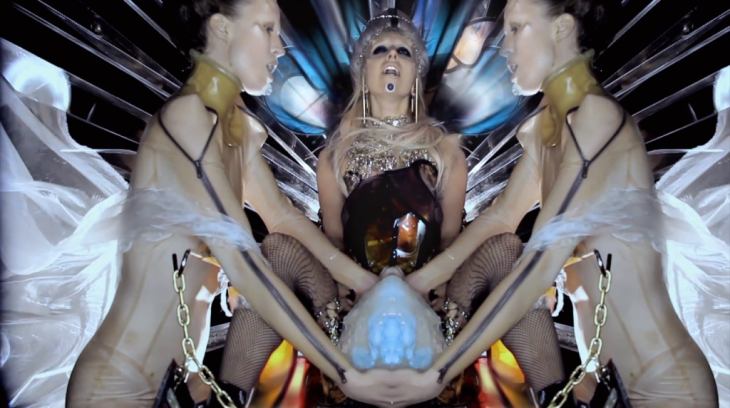“The nexus of Born This Way and the soul of the record reside in this idea that you were not necessarily born in one moment. You have your entire life to birth yourself into becoming the ultimate potential vision that you see for you. Who you are when you come out of your mother’s womb is not necessarily who you will become. Born This Way says your birth is not finite, your birth is infinite.”
Lady Gaga
(talking about the meaning of Born This Way)
The first song written and recorded for the album was the title track itself which she wrote in Liverpool and Manchester, England, described by Lady Gaga as a “magical message” song. She wrote it in ten minutes and compared the process to an Immaculate Conception.
“I want to write my this-is-who-the-fuck-I-am anthem, but I don’t want it to be hidden in poetic wizardry and metaphors. I want it to be an attack, an assault on the issue because I think, especially in today’s music, everything gets kind of washy sometimes and the message gets hidden in the lyrical play. Hankering back to the early ’90s, when Madonna, En Vogue, Whitney Houston and TLC were making very empowering music for women and the gay community and all kind of disenfranchised communities, the lyrics and the melodies were very poignant and very gospel and very spiritual and I said, ‘That’s the kind of record I need to make. That’s the record that’s going to shake up the industry.’ It’s not about the track. It’s not about the production. It’s about the song. Anyone could sing Born This Way. It could’ve been anyone.”
Nick Knight directed the accompanying music video, which was inspired by painters like Salvador Dalí and Francis Bacon and their surrealistic images. Gaga is depicted as giving birth to a new race during a prologue. A series of dance sequences later, the video concludes with the view of a city populated by this race. Critics noted cultural references to the work of Madonna, Michael Jackson, Björk, late fashion designer Alexander McQueen, as well as to Greek mythology, magical realism and surrealism.
Laurieann Gibson explained the inspiration behind the video to MTV News:
“When she played it for me, it took me a while to find out the visual interpretation that I could give back to her. And so I woke up one night and I got it, and I said, ‘I got it: We have to birth a new race.’ From the gate, Gaga was like, ‘I want Nick Knight for this video. I want a visual.’ She was always birthing something visual in her head, and Nick Knight is just, well, he’s prolific but he’s so genius. It was about pushing the bar of what a music video should be and can be. […] It’s a different time; it’s a different era; there are no limits. It is a viral message. I think that there’s something in there for everyone, and that’s what’s so amazing about the video and so specific about the message.”
Released on Monday, February 28, 2011, the video begins with a brief shot of a unicorn’s silhouette in a steam-filled alley, inside a pink triangle frame. The triangle transitions to a shot of Gaga, with two opposite facing heads, inspired by Janus, the Roman god of transition and beginnings, sitting in an ornate glass throne amidst a star-filled space. As Bernard Herrmann‘s prelude to the movie Vertigo (Alfred Hitchcock, 1958) plays, Gaga tells the story of the creation of an extraterrestrial race that “bears no prejudice, no judgment, but boundless freedom.” Gaga sits in the throne, giving birth to a “new race within the race of humanity.” She explains that this was followed by the birth of evil, due to which Gaga splits into two opposing forces of good and evil. Her new half gives birth to a machine gun and fires it. The prologue concludes with Gaga questioning, “How can I protect something so perfect, without evil?”
The video featured full-bodied tattooed model Rick Genest (Rico), better known by his stage name Zombie Boy. Gaga painted her face in a similar way to Genest, in one of the main series of sequences. She said that the sequences displayed the fact that she would not allow society or critics to dictate her sense of beauty. “I tell you what I think is beauty, and hence the scene was of me and Rico defining ourselves in artistic way and not relying on society to dictate it,” she added. The costumes for the video were designed by Nicola Formichetti, who blogged about the various designer pieces shown in it. In the opening sequence of the video, Gaga wore a head accessory by Alexis Bittar, a diamond neckpiece by Erickson Beamon with earrings by Pamela Love, and a stained-glass dress by Petra Storrs. Finger rings were provided by Erickson Beamon and chiffon clothes by Thierry Mugler. For the skeletons sequences, both she and Rico wore tuxedos by Mugler while the slime during the orgy scenes were courtesy of Bart Hess. For her Michael Jackson impression in the alley at the video’s end, Gaga wore shirt and pants by Haus of Gaga, shoes by Natacha Marro, a Billykirk belt and LaCrasia gloves.








































